Welcome! Ready to explore Pohang? Nestled on the eastern shoreline of South Korea, Pohang is a city that offers a unique blend of industrial might and natural beauty. While it may be renowned as the heartland of South Korea’s steel industry, thanks to the giant POSCO steel plant, Pohang also boasts scenic coastlines, vibrant cultural festivals, and mouth-watering seafood. Let’s dive into what makes Pohang a must-visit for those looking to uncover all that Korea has to offer beyond its bustling metropolises.

Coastal Charm
Seaside Splendor: Pohang’s coastline is a tapestry of rugged cliffs, serene beaches, and hidden coves. Guryongpo Beach and Chilpo Beach are perfect for those sunny days when all you want is the sand between your toes and the sound of waves. Don’t miss the Homigot Sunrise Plaza, where you can catch the first sunrise of the year on mainland Korea. It’s not just a beach; it’s a celebration of light, with sculptures and installations that playfully interact with the rising sun.
Industrial Might
Steel Yourself for Innovation: A tour of the POSCO steel plant isn’t just for those interested in engineering. It’s a glimpse into the powerhouse that helped forge modern Korea. This sprawling complex is not only about its past achievements but also its future in sustainable technology. It’s an unexpectedly fascinating peek into a world where fiery furnaces and towering cranes shape the skyline.
Cultural Richness
A City Alive with Festivals: Pohang comes alive with the Pohang International Fireworks Festival, where the night sky bursts into colors, and the steelworks provide a dramatic backdrop. Another not-to-be-missed event is the Pohang Steel Art Festival, which transforms scraps from POSCO into stunning art installations. These events draw visitors from all over Korea and beyond, blending art, culture, and community in a dynamic display.
Culinary Delights
Seafood and More: Thanks to its coastal location, Pohang is a haven for seafood lovers. From freshly caught squid to sumptuous king crabs, the local cuisine is a delightful exploration of oceanic flavors. Explore the Jukdo Market, where the day’s catch goes straight from the sea to your plate. Here, food isn’t just eaten; it’s experienced.
Natural Wonders
Beyond the Beach: Venture beyond the city to explore the nearby mountains and hiking trails. Naeyeonsan Mountain and the Twelve Waterfalls offer a refreshing retreat from the urban environment. These natural sites provide not only peace but also spectacular photographic opportunities throughout the seasons.
Pohang might surprise you with its mix of industrial heritage and natural beauty, all enriched by a strong sense of community and tradition. Whether you’re here to soak up the sun on its beaches, delve into the heart of its industrial landscape, or feast on some of the freshest seafood around, Pohang offers a diverse palette of experiences. So why not add Pohang to your travel itinerary and discover another side of South Korea?
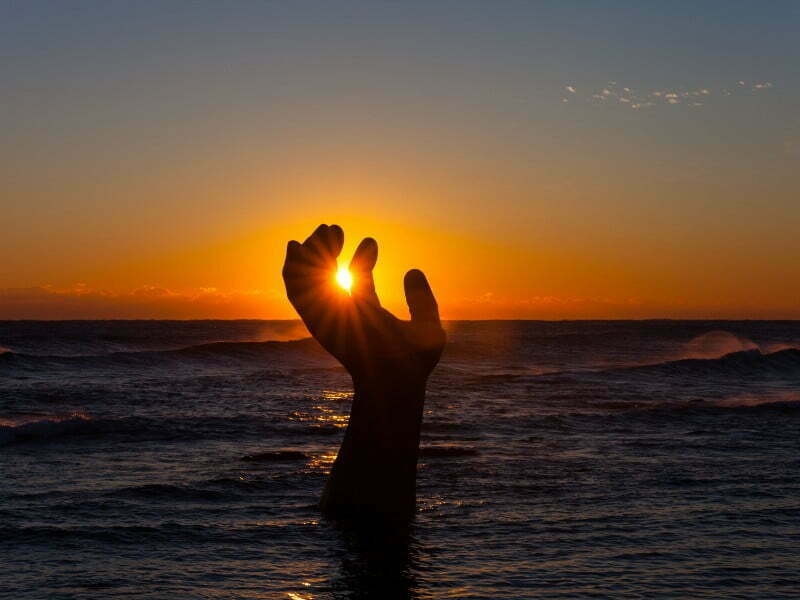
Pohang City Guide: A Brief History Of Pohang, Korea
Pohang’s story is not just about its industrial prowess but also about its ancient cultural roots and key historical events. From prehistoric settlements to dynastic developments and modern marvels, Pohang offers a fascinating chronicle that enhances its seaside charm.
Ancient Beginnings
Tracing Roots Back to Prehistory: Pohang’s history stretches back thousands of years, marked by early human settlements evident in archaeological sites like Guryongpo. These sites have unearthed relics from the Bronze Age and evidence of vibrant ancient communities. The area’s strategic coastal location made it a focal point for fishing and trade, which helped to cultivate a rich maritime culture that is still celebrated today.
The Goryeo and Joseon Dynasties
Dynastic Influences and Developments: During the Goryeo and Joseon eras, Pohang was known as a key provincial outpost. It was often referred to by its old name, Lighthouse Point, due to its critical role in coastal defense and as a beacon for the many ships navigating the East Sea. The construction of various fortifications and watchtowers along the coast underscores Pohang’s importance in Korea’s historical military strategies.
The Rise of Modern Industry
From Rural Outpost to Industrial Giant: The modern era transformed Pohang with the establishment of POSCO in 1968, which catalyzed its development into a powerhouse of the steel industry. This move was pivotal in South Korea’s rapid economic development, known globally as the Miracle on the Han River. The steel mill not only reshaped Pohang’s economic landscape but also its physical and social fabric, attracting workers from across Korea and fostering a unique industrial community.
Cultural Revival
Preserving and Celebrating Heritage: Despite its industrialization, Pohang has not forgotten its roots. The city actively preserves its historical sites and celebrates its long history through various festivals and events. For instance, the Pohang Steel Art Festival not only showcases the city’s modern capabilities but also honors its ancient metalworking traditions, linking past to present in creative expressions.
A Legacy of Resilience and Innovation
Looking to the Future: Today, Pohang stands as a testament to Korean resilience and forward-thinking. The city continues to innovate, particularly in areas of green technology and sustainable development, while remaining proud of its historical and cultural achievements. Its universities and research institutes contribute to its reputation as a place of learning and innovation, furthering the legacy of a city built on both tradition and transformation.
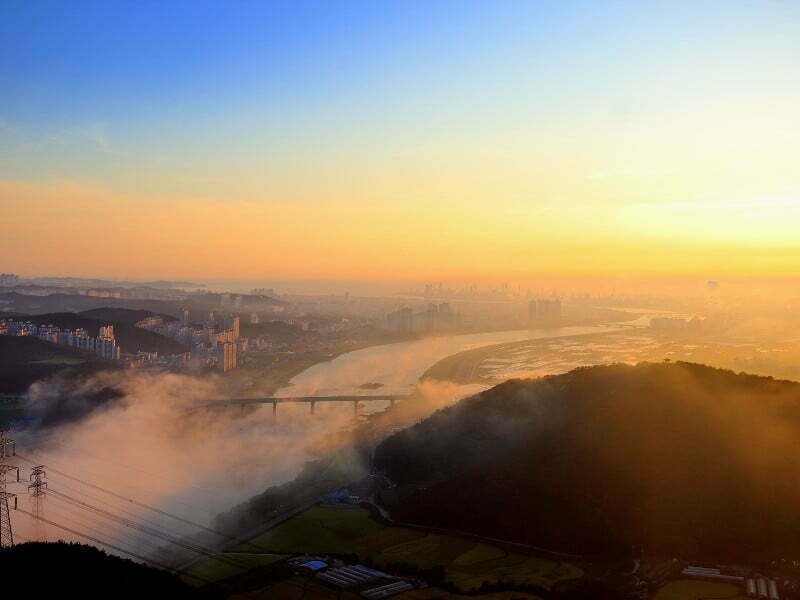
Pohang Top Attractions and Best Places to Visit in South Korea
Begin your time in Pohang by dropping by Bogyungsa Temple. Founded at the dawn of the 7th century, this Buddhist hall of worship is ancient. Despite this fact, it is not dissimilar to many other temples around the country.
Thus, it puzzles many visitors why this place is so popular. In actuality, this sight is most famous for the waterfalls and hiking trails accessible from its grounds. A dozen waterfalls are reachable from this temple – visit in the spring, when rainfalls ensure heavy flows.
Want to spend time amidst this inspiring natural landscape? Try a temple stay – you’ll get to participate in the monastic life, afterwards, you’ll know who you truly are.
If you’re still in the mood to check out temples after Bogyungsa, be sure to visit Oeosa Temple. Like its cousin, Oeosa came into being during the Silla Period – carbon dating puts it around the 6th century.
It got its name from a folk tale – one day, two monks came upon two dead fish in a lake. As they gazed upon them, one suddenly sprang back to life. Oeosa was a word for “fish” back then, giving their temple its current name.
More Attractions
In addition to the usual Buddha statues, you’ll find plenty of fish statues and carvings around. Apart from this, it’s another peaceful temple in a stunning mountain environment. Check out the small museum on site – it’s free and contains a bronze bell from the 13th century.
Over the latter half of the 20th century, Pohang became one of South Korea’s most prominent industrial cities. POSCO is one of its largest firms, contributing the steel that led to the rise of this Asian tiger.
Learn about its history by visiting the Posco Museum. Through its exhibits, you’ll learn about the development of the steel industry in Korea. From the 50s to today, incredible volumes of steel rolled off their lines, helping this nation rise to greatness.
After checking out the museum, you’ll have the option to go on a factory tour. As you move through the facility, your guide will explain each process in a relatable way. For this reason, it is an excellent attraction for those into the industry.
If you are visiting Korea between late May and Early June, be sure to attend the Pohang International Fireworks Festival. Each night, a different team will put on an impressive pyrotechnical display above Yeongil Bay. Before the show, there are also parades, street performers, and plenty of amazing Korean street food – don’t miss out.
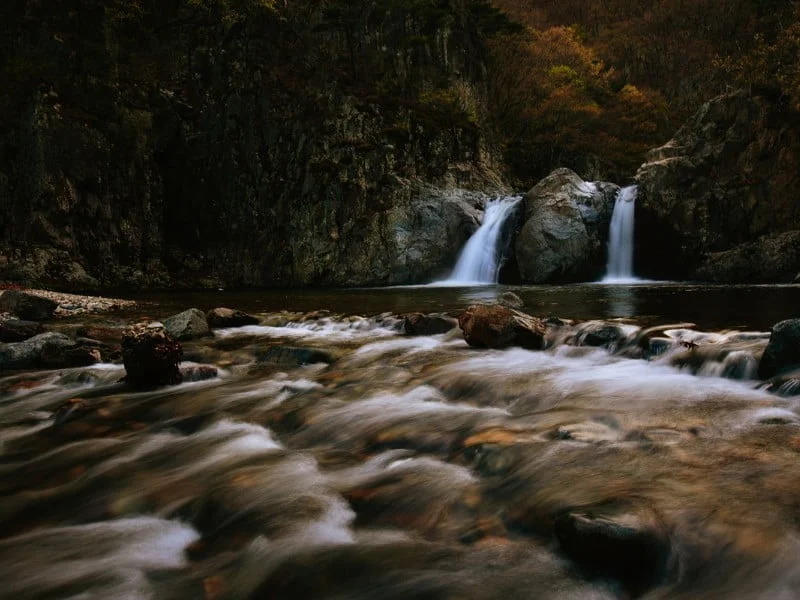
Other Cultural Attractions: Trip to Pohang, Korea
If you need to escape the city during your time in Pohang, make plans to check out Naeyeonsan County Park. It protects the land around Naeyeonsan Mountain, a peak that rises 930 metres above sea level. With trails that lead to stunning waterfalls, a day here will go a long way toward recharging your batteries.
Pohang is an important fishing port on the East Sea. See the latest catches of their fishers by dropping by the Jukdo Market. Within, over 200 vendors hawk everything from giant tunas to a bewildering array of shellfish. A hop, skip, and a jump away, restaurants stand ready to prepare the freshest seafood you’ve ever eaten. If you are a fan, you owe it to yourself to have a meal here.
Other Attractions
Stand at Korea’s most eastern point at Homigot Sunrise Square. Each New Year’s Day, Koreans from across the country gather to witness the first sunrise of the new year. Don’t worry if you’re not around then – plenty come to watch at other times of year as well.
Art lovers will appreciate the sculptures found here. Cast in bronze, they depict a set of hands that symbolize the land and the ocean. Together, they make a case for reconciliation and co-existence, something we should all get behind.
If you are visiting Pohang during the summer months, the heat can be rather stifling. Cool off by spending an afternoon on Yeongildae Beach. With off-white sand, refreshing water, and samishi restaurants within easy reach, there are few better places to relax on a summer day than here. Do as the locals do and pitch a tent – it will shield you from the sun as you relax.
source: cari cakes on YouTube
Top 33 Things To Do in Pohang, South Korea For Visitors
Here are the top 33 things to do in Pohang:
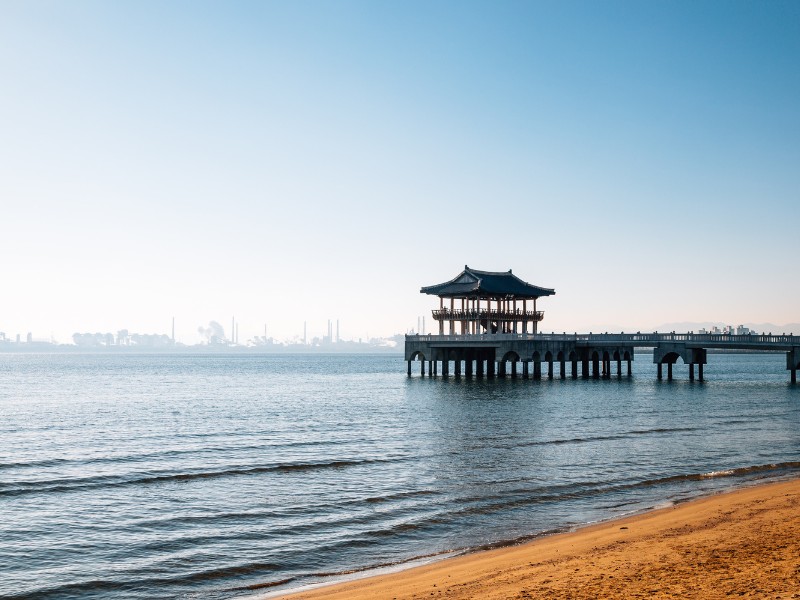
1. Visit Homigot Sunrise Square
Witness the spectacular sunrise at Homigot Sunrise Square, home to the famous “Hand of Harmony” sculpture. This iconic landmark is particularly popular on New Year’s Day when people gather to see the first sunrise of the year. The area offers stunning coastal views and a peaceful atmosphere that’s perfect for reflection. It’s a symbol of hope and unity, attracting visitors from all over Korea.
- Iconic sculpture: See the majestic “Hand of Harmony” reaching out from the sea.
- Breathtaking sunrise: Experience the first rays of sunlight touching Korea.
- Symbolic spot: Feel the unity and optimism this place embodies.
2. Explore Guryongpo Modern History Street
Take a walk down Guryongpo Modern History Street to see well-preserved Japanese-style houses from the early 20th century. This area offers a unique glimpse into life during the Japanese occupation. Enjoy traditional Japanese tea at one of the converted teahouses and immerse yourself in the historical ambiance. The street also hosts cultural events and festivals throughout the year.
- Time travel: Wander through streets frozen in the early 1900s.
- Cultural fusion: Savor tea in authentic Japanese-style teahouses.
- Festive vibes: Experience lively events and festivals year-round.
3. Relax at Yeongildae Beach
Yeongildae Beach is one of Pohang’s most popular sandy stretches, offering excellent facilities for swimming, sunbathing, and water sports. The beachfront is lined with cafes, restaurants, and bars, making it a lively place both day and night. It’s also renowned for its beautiful sunset views over the East Sea. During the summer, the beach hosts various music and cultural festivals.
- Beach fun: Enjoy swimming and water sports in clear waters.
- Vibrant nightlife: Explore beachfront cafes and bars after sunset.
- Festival hotspot: Join in on summer music and cultural events.
4. Discover the Pohang Steel Art Festival
Experience the unique blend of industry and art at the Pohang Steel Art Festival. This event celebrates the city’s industrial heritage through stunning steel sculptures, installations, and performances by artists worldwide. It’s a testament to Pohang’s identity as a steel city with a creative twist. The festival also includes workshops and interactive activities for all ages.
- Artistic innovation: Marvel at sculptures crafted from steel.
- Cultural celebration: Participate in performances and workshops.
- Industrial pride: Learn about Pohang’s steel-making legacy.
5. Visit the POSCO Museum
Learn about the history and technology behind one of the world’s largest steel companies at the POSCO Museum. The museum offers interactive exhibits, models, and videos showcasing the steel-making process. It’s an educational journey highlighting Pohang’s industrial achievements. The museum also emphasizes POSCO’s commitment to sustainability and innovation.
- Industrial insight: Understand steel production from start to finish.
- Interactive exhibits: Engage with hands-on displays and models.
- Sustainability focus: Discover POSCO’s green initiatives.
6. Hike in Naeyeonsan Mountain and the Twelve Waterfalls
Naeyeonsan Mountain offers scenic hiking trails leading to the breathtaking Twelve Waterfalls. The area is a natural paradise with lush forests, crystal-clear streams, and diverse wildlife. It’s an ideal spot for photography, picnicking, and immersing yourself in nature. The mountain and waterfalls provide a tranquil escape from city life.
- Nature’s beauty: Hike through verdant forests and cascading falls.
- Outdoor adventure: Perfect for hikers of all skill levels.
- Peaceful retreat: Unwind amidst serene natural surroundings.
7. Explore Bogyeongsa Temple
Nestled in Naeyeonsan Mountain, Bogyeongsa Temple is known for its serene atmosphere and stunning natural backdrop. The temple complex includes historic buildings, pagodas, and statues reflecting Korea’s Buddhist heritage. Participate in temple stay programs to experience Buddhist culture and meditation firsthand. The temple is especially beautiful in spring when azaleas bloom.
- Spiritual journey: Discover centuries-old Buddhist traditions.
- Cultural immersion: Engage in meditation and temple activities.
- Seasonal splendor: Visit during spring for vibrant floral displays.
8. Enjoy the Pohang International Fireworks Festival
The Pohang International Fireworks Festival lights up the sky with spectacular displays over Yeongildae Beach. This event attracts visitors from across Korea and beyond, featuring music, performances, and various entertainment. It’s a celebration of light and sound that creates unforgettable memories. The festival is a highlight of Pohang’s cultural calendar.
- Sky spectacle: Witness mesmerizing fireworks shows.
- Festive atmosphere: Enjoy live music and performances.
- Family fun: Perfect event for all ages to enjoy together.
9. Visit the Jukdo Market
Jukdo Market is one of the largest seafood markets in Korea, offering fresh fish, shellfish, and other marine delights. Explore the bustling stalls, sample local seafood delicacies, and learn about Korea’s fishing industry. The market also sells fruits, vegetables, and traditional snacks. It’s a vibrant place to experience local culture and cuisine.
- Seafood haven: Feast on the freshest catches of the day.
- Local flavors: Try traditional Korean street food.
- Cultural experience: Immerse yourself in the market’s lively buzz.
10. Take a Stroll Along Hwanho Park
Hwanho Park is a scenic area along the Hyeongsan River, offering walking paths, gardens, and recreational facilities. It’s a popular spot for jogging, cycling, and family outings. The park features beautiful flower displays in spring and colorful foliage in autumn. It also hosts cultural events and open-air concerts.
- Outdoor leisure: Enjoy a leisurely walk or bike ride.
- Seasonal beauty: Witness stunning blossoms and fall colors.
- Community events: Attend concerts and festivals in the park.
11. Admire Oeosa Temple
Oeosa Temple is a tranquil Buddhist sanctuary located beside a picturesque lake. Surrounded by mountains and forests, it’s the perfect place for reflection. Admire the traditional Korean temple architecture and soak in the peaceful ambiance. The temple grounds are especially breathtaking in the fall when leaves change color.
- Serene setting: Experience tranquility amidst natural beauty.
- Architectural delight: Appreciate classic temple designs.
- Autumn wonderland: Visit for stunning fall foliage.
12. Discover the Underwater Tomb of King Munmu
Located near Bonggil Beach, the Underwater Tomb of King Munmu is a unique historical site. King Munmu, the 30th king of the Silla Kingdom, wished to protect his kingdom even in death, leading to his burial at sea. View the tomb from the shore and learn about his legacy in Korean history. It’s a fascinating glimpse into Korea’s ancient past.
- Historical intrigue: Uncover the story of a king’s final wish.
- Cultural insight: Understand the significance of the Silla Kingdom.
- Scenic spot: Enjoy coastal views while exploring history.
13. Visit the Pohang Canal
Inspired by Venice, the Pohang Canal is a charming waterway running through parts of the city. Enjoy boat rides, stroll along the canal paths, and explore surrounding cafes and shops. The area is beautifully lit at night, creating a romantic atmosphere. It’s a unique urban attraction adding to Pohang’s charm.
- Romantic ambiance: Take a leisurely boat ride under twinkling lights.
- Scenic walks: Wander along picturesque canal paths.
- Café culture: Relax in nearby cafes overlooking the water.
14. Explore Hyoja-dong Mural Village
Hyoja-dong Mural Village is a vibrant community where artists have transformed walls into colorful murals. It’s a fun and engaging way to explore art in public spaces. Wander through narrow streets, discovering new artworks at every turn. The murals depict various themes, from local history to contemporary issues.
- Artistic exploration: Discover creative murals around every corner.
- Cultural expression: Learn about local stories through art.
- Photography haven: Capture vibrant and unique backdrops.
15. Experience the Pohang Steelworks Tour
Take an exclusive tour of the Pohang Steelworks, one of the largest steel plants in the world. Get a behind-the-scenes look at the steel production process, from raw materials to finished products. It’s an eye-opening experience showcasing the scale of Pohang’s steel industry. Note: Booking in advance is required due to limited spaces.
- Industrial marvel: Witness steel-making on a massive scale.
- Educational visit: Learn about cutting-edge manufacturing processes.
- Advance booking: Ensure your spot by reserving early.
16. Visit the Korean War Memorial of Pohang
The Korean War Memorial of Pohang honors soldiers who fought and sacrificed during the Korean War. The memorial park features statues, monuments, and an exhibition hall with artifacts and photos. It’s a place of reflection and education about Korea’s modern history. Gain a deeper understanding of the war’s impact on Pohang and the nation.
- Honoring heroes: Pay respects to those who served.
- Historical artifacts: Explore exhibits detailing wartime events.
- Reflective space: Contemplate in a serene environment.
17. Relax at Chilpo Beach
Chilpo Beach is known for its clear waters, fine sand, and scenic cliffs. It’s a quieter alternative to Yeongildae Beach, perfect for relaxation and natural beauty. Enjoy swimming, sunbathing, and beach sports in a peaceful setting. Nearby hiking trails offer stunning views of the coastline.
- Seaside serenity: Unwind on a tranquil beach.
- Outdoor activities: Swim or hike with ocean views.
- Natural landscapes: Admire the meeting of sea and cliffs.
18. Take a Day Trip to Gyeongju
Gyeongju, the ancient capital of the Silla Kingdom, is a short drive from Pohang. Rich in history, it boasts UNESCO World Heritage Sites, royal tombs, and Buddhist temples. Explore the Gyeongju National Museum, Bulguksa Temple, and the Seokguram Grotto. It’s a must-visit for history and culture enthusiasts.
- Historical treasure: Discover Korea’s ancient capital.
- Cultural sites: Visit temples and royal tombs.
- Educational journey: Learn about the Silla Dynasty’s legacy.
19. Explore Wolpo Beach and Sand Dunes
Wolpo Beach, near Pohang, features unique sand dunes offering a desert-like landscape by the sea. These dunes are a rare natural phenomenon in Korea, providing a unique backdrop for photos. The beach itself is peaceful, with clear waters and a relaxed atmosphere. Enjoy sandboarding, picnics, and leisurely walks along the shore.
- Unique terrain: Experience sand dunes by the ocean.
- Adventure spot: Try sandboarding on the dunes.
- Scenic relaxation: Picnic with panoramic sea views.
20. Discover the Charm of Chilseong Market
Chilseong Market is one of Pohang’s oldest traditional markets, known for its lively atmosphere and diverse products. Find everything from fresh seafood to clothing and household goods. It’s also a great place to sample local street food and traditional dishes. Experience the authentic daily life of Pohang’s residents.
- Market bustle: Immerse yourself in local commerce.
- Culinary delights: Taste traditional Korean foods.
- Shopping variety: Browse a wide range of goods.
21. Visit the POSCO History Museum
The POSCO History Museum details the journey of POSCO, a global steel industry leader originating in Pohang. Exhibits showcase the company’s development, technological advancements, and contributions to the industry. It’s insightful for those interested in industrial history and economic growth. The museum also highlights POSCO’s environmental efforts.
- Corporate legacy: Trace POSCO’s rise to prominence.
- Technological innovation: Learn about advances in steelmaking.
- Sustainability efforts: Understand environmental initiatives.
22. Stroll Through Songdo Park
Songdo Park is a spacious urban oasis offering lush greenery, walking paths, and recreational facilities. It’s a popular spot for outdoor activities like jogging, cycling, and family picnics. The park features a pond, sports fields, and playgrounds for children. It’s a refreshing green space enhancing city life.
- Urban escape: Enjoy nature within the city limits.
- Family-friendly: Plenty of activities for kids and adults.
- Active lifestyle: Ideal for sports and fitness enthusiasts.
23. Admire the Beauty of Cheongho Park
Known for its beautiful bridge and serene lake, Cheongho Park is a picturesque location for relaxation. The park is beautifully landscaped with walking trails, flower gardens, and art installations. It’s particularly stunning in the evening when the bridge and pathways are illuminated. The park also hosts cultural events and festivals.
- Scenic spot: Capture photos of the illuminated bridge.
- Leisurely walks: Stroll through tranquil gardens.
- Cultural hub: Attend events in a beautiful setting.
24. Explore Odo Coastal Walkway
The Odo Coastal Walkway offers breathtaking views of the sea and coastline along its several-kilometer stretch. It’s excellent for leisurely walks, jogs, or bike rides. The walkway features lookout points, rest areas, and access to small beaches. Experience Pohang’s natural beauty and invigorating sea air.
- Spectacular views: Enjoy panoramic ocean vistas.
- Outdoor enjoyment: Walk or cycle along the scenic path.
- Hidden gems: Discover secluded beaches along the way.
25. Experience Traditional Korean Life at Yangdong Folk Village
Although closer to Gyeongju, Yangdong Folk Village is easily accessible from Pohang and offers a glimpse into traditional Korean life. As a UNESCO World Heritage Site, it features well-preserved houses, Confucian academies, and natural surroundings. Learn about Korean customs, architecture, and rural life. Participate in cultural demonstrations and workshops.
- Cultural immersion: Step back into Korea’s past.
- Educational tours: Understand traditional Korean society.
- Interactive experiences: Join in on cultural activities.
26. Enjoy Outdoor Activities at Yeongdeok Blue Road
Yeongdeok Blue Road, stretching along the coast north of Pohang, is renowned for scenic beauty and outdoor fun. Hike, cycle, or drive while enjoying views of the East Sea, cliffs, and beaches. Pass through fishing villages and seafood restaurants to taste fresh local seafood. It’s ideal for nature lovers and adventure seekers.
- Coastal journey: Traverse stunning seaside routes.
- Culinary stops: Indulge in fresh seafood delicacies.
- Active exploration: Engage in hiking and cycling.
27. Admire Local Art at Pohang Museum of Steel Art
The Pohang Museum of Steel Art combines industrial heritage with artistic expression. It showcases sculptures and installations made from steel, reflecting Pohang’s identity as a steel city. The museum also features exhibits on the history of steel art. Don’t miss the outdoor sculpture park for an interactive art experience.
- Artistic fusion: See creativity forged in steel.
- Cultural insight: Learn about the intersection of art and industry.
- Interactive exhibits: Engage with art in the outdoor park.
28. Learn at the National Lighthouse Museum
Located near Pohang, the National Lighthouse Museum is dedicated to the history and technology of lighthouses in Korea. Explore models, photographs, and interactive exhibits. Gain insight into the role of lighthouses in maritime safety. It’s educational for all ages and highlights Korea’s coastal heritage.
- Maritime history: Discover the evolution of lighthouses.
- Interactive learning: Enjoy hands-on exhibits.
- Family outing: Fun and informative for kids and adults.
29. Relax at Oeosa Temple
Revisit Oeosa Temple for a peaceful retreat away from city life. Its beautiful setting beside a tranquil lake, surrounded by mountains, makes it perfect for meditation and reflection. Explore the temple grounds and appreciate traditional Buddhist architecture. Participate in cultural and religious events to deepen your experience.
- Peaceful escape: Find serenity in natural surroundings.
- Cultural practices: Engage in temple activities.
- Natural harmony: Connect with nature and spirituality.
30. Enjoy the Views from Daewangam Park
Daewangam Park is known for rugged cliffs, dense forests, and the impressive Daewangam Rock formation. Scenic walking paths lead to observation decks with stunning sea and coastline views. It’s a fantastic spot for photography, picnics, and leisurely walks. The park’s natural beauty is a must-see for visitors.
- Clifftop vistas: Admire breathtaking coastal scenery.
- Nature walks: Explore lush forest trails.
- Rock formations: Visit the legendary Daewangam Rock.
31. Visit the Pohang Iron and Steel History Museum
The Pohang Iron and Steel History Museum highlights the city’s pivotal role in Korea’s industrialization. Featuring historical documents, photographs, and models, it illustrates the growth of Pohang and POSCO. It’s informative for those interested in industrial history and South Korea’s economic transformation.
- Economic evolution: Learn about industrial advancements.
- Historical context: Understand Pohang’s development.
- Educational exhibits: Explore the steel-making process.
32. Discover the Charms of Heunghae-eup
Heunghae-eup, a small town near Pohang, offers traditional markets, temples, and scenic countryside. Explore cultural sites, enjoy local cuisine, and experience warm hospitality. Surrounded by fields and mountains, it provides beautiful landscapes for exploration. It’s a quaint destination showcasing rural Korean charm.
- Local culture: Experience everyday life in a Korean town.
- Culinary treats: Taste authentic regional dishes.
- Natural beauty: Enjoy the serene countryside setting.
33. Experience Pohang’s Festivals and Cultural Events
Pohang hosts various festivals and cultural events throughout the year, celebrating its heritage, cuisine, and community spirit. From the Pohang International Fireworks Festival to local food festivals, there’s always something happening. Engage with local culture, enjoy performances, and sample regional delicacies. Attending a festival is a fantastic way to immerse yourself in Pohang’s vibrant life.
- Year-round festivities: Find events no matter when you visit.
- Cultural celebration: Participate in traditional and modern activities.
- Community engagement: Meet locals and share in their traditions.
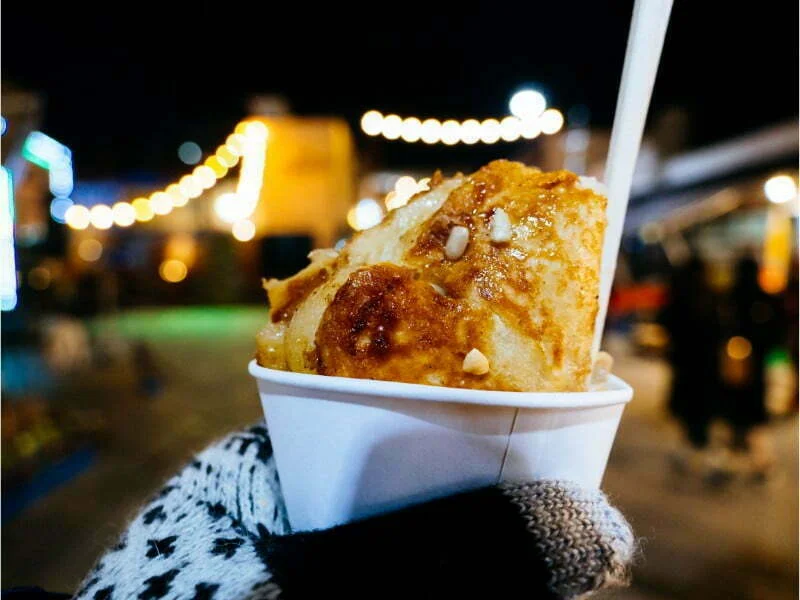
What To Eat and Drink in Pohang, South Korea
Pohang’s location on the eastern coast of South Korea blesses it with an abundance of seafood, making it a haven for gastronomes. Beyond just seafood, the city also offers a variety of other delightful Korean dishes and beverages. Dive into the culinary delights of Pohang with this comprehensive guide.
1. Gwamegi (Half-Dried Pacific Herring or Saury)
One of Pohang’s signature dishes, gwamegi is made by drying either Pacific herring or saury during the winter. The process gives the fish a unique texture—somewhere between fresh and fully dried. It’s usually eaten with fresh vegetables, garlic, and chili paste (gochujang) or served with hot rice.
2. Snow Crab
Jumunjin, a district within Pohang, is particularly renowned for its snow crab. The crab is either steamed to perfection, retaining its natural flavor and sweetness, or used in various dishes, including stews and soups.
3. Agujjim (Steamed Monkfish)
Originally from Masan, this dish has also become popular in Pohang. Agujjim is made of monkfish and bean sprouts, seasoned with soy sauce, gochujang, and various spices. The dish offers a wonderful combination of the delicate flavors of the fish and the spiciness of the sauce.
4. Grilled Eel
A popular dish throughout Korea, in Pohang, eel is often grilled with a special marinade and served over rice. Rich in vitamins and known for its stamina-boosting properties, eel is a favorite, especially during the hot summer months.
5. Hoe (Raw Fish)
Being a coastal city, Pohang offers some of the freshest seafood in the country. Hoe is thinly sliced raw fish, often served with side dishes like kimchi, fresh vegetables, and a dipping sauce made from soy sauce and wasabi. The texture and taste of the fish, paired with the sharpness of the wasabi, make for a delectable combination.
6. Makgeolli
While this fermented rice beverage is popular throughout Korea, the coastal influence of Pohang might introduce you to unique seafood pairings. The milky, slightly carbonated drink has a subtle sweetness that complements the flavors of Pohang’s seafood.
7. Soju
No list about Korean beverages would be complete without mentioning soju, the ubiquitous Korean spirit. Typically distilled from rice or grains, soju is often enjoyed with meals and is a staple of Korean dining culture.
8. Seaweed Soup (Miyeok-guk)
Traditionally eaten on birthdays, this nutritious soup made from seaweed is believed to provide health benefits, including good skin and detoxification.
9. Tteokbokki with Seafood
While tteokbokki (spicy rice cakes) is a popular street food all over Korea, in Pohang, it’s not uncommon to find versions enhanced with fresh seafood, adding depth to the dish.
10. Bingsu
For dessert, try bingsu, a shaved ice dish topped with various ingredients like sweet red beans, fruit, and condensed milk. In Pohang, you might find variants topped with local fruits or even seafood-inspired flavors.
11. Local Teas
Korea boasts a variety of traditional teas. In Pohang, look for establishments that serve teas made from local ingredients, such as barley, ginger, or jujube. These teas not only warm the soul but are also believed to offer health benefits.
12. Pajeon (Korean Pancake)
A perfect accompaniment to a rainy day, Pajeon is a savory pancake made with scallions. The seafood version, Haemul Pajeon, is loaded with various seafood and is especially popular in Pohang.
13. Dongdongju
Similar to makgeolli but with rice grains left in, dongdongju is a delightful, slightly fizzy traditional drink often served in a bowl. Pair it with pajeon for a classic Korean combo.
14. Grilled Shellfish
Being a coastal city, Pohang’s selection of fresh shellfish is commendable. Clams, mussels, and scallops are grilled right at your table and best enjoyed with a splash of lemon or a dab of chili paste.
15. Janchi Guksu
Translating to “banquet noodles”, this dish features thin wheat noodles in a light broth, often garnished with vegetables and seafood. It’s a simple yet flavorful dish, symbolizing celebration and festivity.
source: Adrienne Hill on YouTube
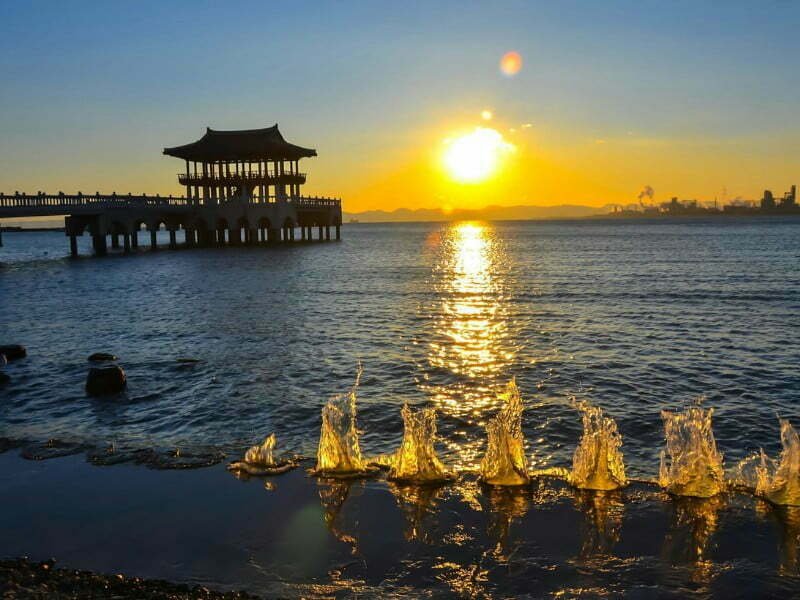
Tours For Visitors To Pohang, Korea
Here’s a detailed travel guide to the top tours available in Pohang.
1. POSCO Factory Tour
Dive into the heart of Pohang’s industrial landscape with a guided tour of the POSCO steel plant, one of the largest steel producers in the world. This tour offers a rare glimpse into the complex processes of steel making and the innovative technologies that have driven South Korea’s industrial growth. You’ll see firsthand the blast furnaces and the rolling mills in action, a testament to the city’s engineering feats.
2. Guryongpo Peninsula Circuit
Explore the scenic Guryongpo Peninsula with a guided tour that covers the beautiful coastline and the rich history of this fishing region. The tour includes visits to the Guryongpo Modern History Museum, where you can learn about the area’s Japanese colonial past, and a stroll around Homigot Square, famous for its giant hand sculpture and beautiful sunrise views.
3. Historical Sites of Pohang
Step back in time with a tour focused on Pohang’s historical sites. Visit the ancient city of Posong, where you can explore the ruins of old fortresses and temples. The tour includes stops at local museums that showcase artifacts from the Bronze Age and provide insights into the region’s historical development.
4. Naeyeonsan Mountain Waterfall Tour
For nature lovers, a trek to Naeyeonsan Mountain offers a refreshing escape. This guided hike takes you through lush forests to the famous Twelve Waterfalls, a series of stunning cascades linked by scenic trails. The tour is not only a physical adventure but also a chance to learn about the local flora and fauna.
5. Culinary Delights of Pohang
Indulge in Pohang’s culinary scene with a food tour that samples the best local dishes. Visit traditional markets like Jukdo Market to try fresh seafood, including Pohang’s famous snow crabs and squid. Learn about the traditional Korean ways of preparing seafood and enjoy tastings that will satisfy your palate.
6. Sunset Cruise around Pohang Bay
Experience the beauty of Pohang from the water with a sunset cruise around Pohang Bay. Enjoy the coastal views, the cool sea breeze, and the spectacular sunset while learning about the maritime culture of the area. This relaxing tour is perfect for couples and families looking to enjoy an evening at sea.
7. Cultural and Art Tour
Discover Pohang’s vibrant cultural scene with a tour that includes visits to local art galleries and performance centers. See contemporary Korean art installations, watch traditional Korean performances, and possibly meet with local artists. This tour is great for those interested in the artistic expressions that shape modern Korean culture.
8. Eco Tour of Yeongil Bay Wetlands
Take an eco-tour to explore the Yeongil Bay Wetlands, one of Korea’s important ecological sites. This guided tour offers insights into the conservation efforts and the biodiversity of the wetlands, including migratory birds. It’s a fantastic opportunity for photography and bird watching.
9. Pohang Steel Art Festival Tour
If you’re visiting during the Pohang Steel Art Festival, don’t miss a guided tour that explores the various installations and artworks made from steel. This unique festival highlights how industrial materials can be transformed into creative and artistic expressions, reflecting Pohang’s identity as a steel city.
10. Homigot Sunrise Festival Tour
For those visiting around New Year’s, the Homigot Sunrise Festival tour is a must. Participate in local traditions and watch the first sunrise of the year at Homigot, one of the best spots in Korea for sunrise views. The festival atmosphere, filled with performances, local food, and the gathering of thousands under the early morning sky, is an unforgettable experience.
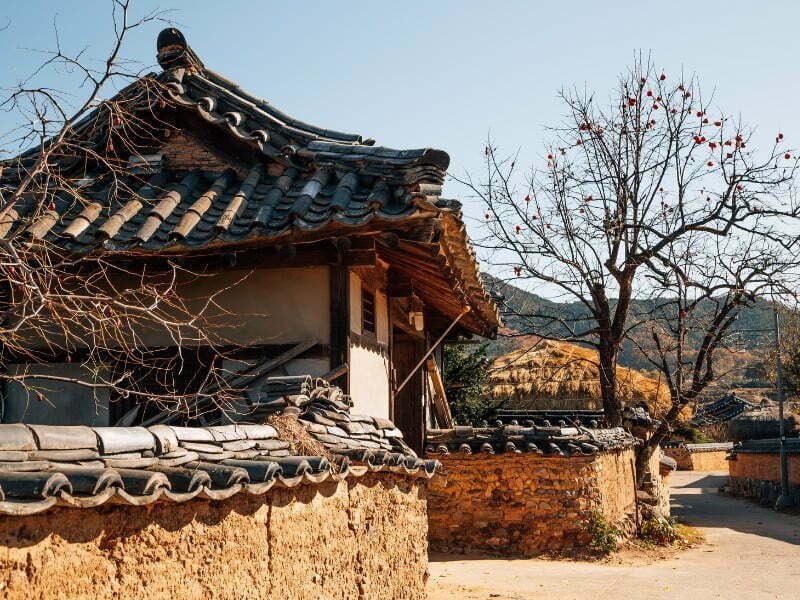
Day Trips From Pohang, South Korea
Pohang’s coastal location and proximity to several cultural and natural wonders make it a prime base for day excursions. Whether you’re looking for historical sites, natural beauty, or bustling urban landscapes, the region surrounding Pohang has a variety of destinations to offer.
source: Samuel and Audrey on YouTube
1. Gyeongju
Distance: Approximately 30 kilometers south of Pohang.
- Overview: Often referred to as “the museum without walls,” Gyeongju was the capital of the ancient Silla Kingdom. It’s packed with historical and cultural heritage sites.
- Highlights:
- Bulguksa Temple: A UNESCO World Heritage site, this temple is an architectural marvel of the Silla era.
- Seokguram Grotto: Located near Bulguksa, this artificial grotto houses a magnificent statue of Buddha.
- Gyeongju National Museum: Gain insight into the rich history and artifacts of the Silla dynasty.
- Royal Tombs: Explore the vast burial mounds of Silla monarchs.
2. Ulsan
Distance: Roughly 55 kilometers southeast of Pohang.
- Overview: Ulsan is a coastal city known for its beaches, industrial complexes, and petrochemical hubs.
- Highlights:
- Taehwagang National Garden: A serene place with beautifully landscaped gardens and a bamboo grove.
- Daewangam Park: A seaside park with walking trails offering panoramic views of the East Sea.
- Petroglyphs of Bangudae: Ancient rock carvings offering a glimpse into prehistoric South Korea.
3. Andong
Distance: Approximately 90 kilometers west of Pohang.
- Overview: Andong is known as the “Capital City of Korean Spiritual Culture” and offers a deep dive into traditional Korean culture and heritage.
- Highlights:
- Andong Hahoe Folk Village: A UNESCO World Heritage site, this village has preserved the Joseon-era homes and traditions.
- Andong Hanji Paper Factory: Witness the traditional process of making Hanji, Korean handmade paper.
- Woryeonggyo Bridge: The longest footbridge in Korea, it offers a scenic view of the Nakdong River.
4. Juwangsan National Park
Distance: Roughly 100 kilometers northwest of Pohang.
- Overview: This national park is renowned for its beautiful valleys, dense forests, and unique rock formations.
- Highlights:
- Daejeonsa Temple: Nestled within the park, it’s a peaceful retreat.
- Jusanji Pond: A tranquil pond surrounded by lush greenery and misty mountains.
- Juwangsan Mountain: Offers several hiking trails with picturesque views.
5. Yeongdeok
Distance: About 80 kilometers north of Pohang.
- Overview: A coastal town known for its snow crabs, Yeongdeok offers beautiful seascapes and seafood delicacies.
- Highlights:
- Yeongdeok Snow Crab Market: Savor the region’s specialty crab dishes.
- Wind Power Theme Park: Offers an insight into renewable energy and panoramic sea views.
- Yeongdeok Sunrise Park: A great spot to catch the early morning sunrise.
6. Ulleungdo Island
Distance: It requires a ferry ride from Pohang Passenger Terminal, typically around 3 hours.
- Overview: Located in the middle of the East Sea, this volcanic island is known for its rugged landscapes, dense forests, and mysterious caves.
- Highlights:
- Dokdo Museum: Learn about the history and significance of the Dokdo islands.
- Nari Basin: A caldera that has transformed into a scenic grassland.
- Seacoast Tour: Experience the pristine waters and intricate coastline.
7. Mungyeong
Distance: About 140 kilometers west of Pohang.
- Overview: Mungyeong is known for its ancient mountain passes, traditional tea culture, and beautiful terrains that make it an ideal place for hiking and enjoying nature.
- Highlights:
- Mungyeong Saejae: An ancient mountain pass and now a provincial park, it was historically one of the main routes connecting Seoul and Busan.
- Mungyeong Traditional Chasabal Festival: Celebrate the pottery and tea culture of Korea.
- Mungyeong Coal Museum: Understand the coal mining history of the region.
8. Bonghwa
Distance: About 110 kilometers northwest of Pohang.
- Overview: Bonghwa is a picturesque county surrounded by mountains and rivers, making it a hub for nature enthusiasts and those seeking a tranquil escape.
- Highlights:
- Buncheon Train Station: Part of the “Train to Nowhere” tour, it offers scenic train rides along the Bonghwa Buncheon Line.
- Sungbo Museum: Learn about the folklore and fairy tales of Korea.
- Naeseongcheon River: Famous for its crystal-clear waters, ideal for fishing and relaxation.
9. Geoje Island
Distance: Approximately 180 kilometers south of Pohang.
- Overview: Geoje Island, connected to the mainland by two bridges, is the second-largest island in Korea and is known for its scenic beaches, shipbuilding yards, and historic sites.
- Highlights:
- Haegeumgang: Rocky cliffs emerging from the sea, it’s a prime spot for boat tours.
- Oedo-Botania: A marine botanical garden offering beautiful landscapes.
- Historical Park of Geoje POW Camp: Offers insight into the life of prisoners during the Korean War.
10. Tongyeong
Distance: About 200 kilometers south of Pohang.
- Overview: Often dubbed as the “Naples of Korea”, Tongyeong is a coastal city known for its seafood, particularly oysters, and its vibrant marine culture.
- Highlights:
- Tongyeong Jungang Market: Delight in fresh seafood and the famous Tongyeong honey bread.
- Hallyeosudo Viewing Ropeway: Experience panoramic views of the surrounding islands and waters.
- Dongpirang Village: A hillside village with colorful murals and art installations.
These additional locales offer a mix of history, nature, and culture, further showcasing the richness and diversity of the regions surrounding Pohang. From the mountainous terrains of Mungyeong to the serene waters of Geoje, day-trippers have a plethora of options to make the most of their Korean adventure.
The regions surrounding Pohang offer a mix of historical richness, natural beauty, and cultural exploration. These destinations ensure that travelers can experience the diversity and depth of South Korea’s landscape and heritage, making Pohang an ideal base for these excursions.
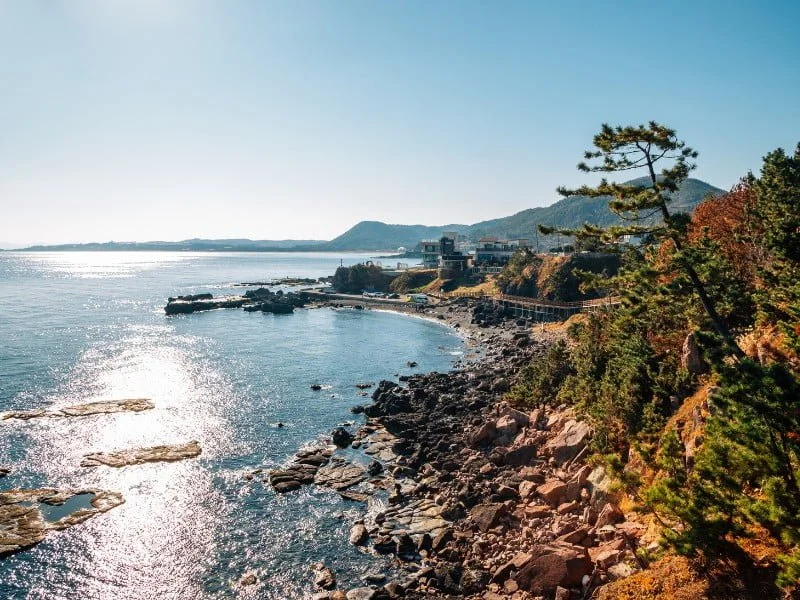
Pohang Transportation Guide
From arriving in the city to getting around its attractions, here’s a comprehensive guide to help you navigate Pohang efficiently.
Arriving in Pohang
1. Pohang Airport Pohang Airport serves domestic flights, mainly from Jeju and Seoul. It’s a convenient entry point if you’re coming from other parts of South Korea. The airport is located about 20 minutes from the city center, and taxis, local buses, or car rental services are readily available for transfers.
2. Intercity Buses Pohang’s Intercity Bus Terminal connects the city with other major locations across South Korea, including Seoul, Busan, and Daegu. Buses are frequent and offer a reliable and economical way to reach Pohang if you’re traveling from another city.
3. Train Services Pohang Station is part of the national railway network, with services linking to major cities such as Seoul and Busan. The train journey offers scenic views of the Korean countryside and is a comfortable alternative to buses or flights.
Getting Around Pohang
4. City Buses Pohang’s bus network covers the city comprehensively, including routes to major attractions, shopping centers, and residential areas. Buses are an affordable way to get around, though understanding the route map might be challenging if you do not speak Korean. Smartphone apps can help you navigate the routes effectively.
5. Taxis Taxis in Pohang are convenient and relatively inexpensive. They can be hailed directly on the streets, booked via phone, or through apps. Taxis are especially useful during late hours when bus services are less frequent.
6. Bicycle Rentals Pohang is a bike-friendly city with several dedicated bike paths, particularly along the coast. Renting a bicycle is a pleasant way to explore the city’s scenic areas, such as the coastline near Homigot and the surroundings of Youngil Bay. Rental shops are available throughout the city, and some hotels offer bikes for their guests.
7. Car Rentals For maximum flexibility, renting a car is a good option, especially if you plan to visit areas outside of the city center or want to explore at your own pace. Several car rental agencies operate in Pohang, including options at the airport and downtown.
8. Walking Many of Pohang’s attractions are located in proximity to each other, especially in the downtown area. Walking can be a pleasant way to explore the city, particularly the areas around the Pohang Stream and the cultural district.
9. Electric Scooters Recently, electric scooters have become available for rent through apps in Pohang. They offer a quick and fun way to cover short distances within the city, adding a modern twist to urban mobility.
Special Transportation
10. Tour Buses For tourists, Pohang offers special tour bus services that cover major attractions like POSCO, Homigot, and Guryongpo. These buses are convenient for visitors who prefer guided tours and would like to gain more insight into the sites they visit.

Where To Visit After Your Trip To Pohang?
From urban excursions to tranquil retreats, these recommendations ensure a rich and varied continuation of your travel experience.
1. Busan
Just a couple of hours away from Pohang, Busan offers a vibrant mix of modern city life and scenic beaches. Explore the bustling Jagalchi Fish Market, relax on Haeundae Beach, one of Korea’s most famous sandy stretches, or hike up to the Beomeosa Temple, set on the forested slopes of Geumjeongsan mountain. Busan’s dynamic mix of culture, cuisine, and architecture makes it a thrilling follow-up to Pohang.
2. Gyeongju
Often referred to as the “museum without walls,” Gyeongju is a short drive from Pohang and is overflowing with historical significance as the ancient capital of the Silla Kingdom. Here, you can visit Bulguksa Temple, a masterpiece of Buddhist art, wander through the Tumuli Park, a collection of royal Silla tombs, or admire the serene Anapji Pond, especially beautiful at night. Gyeongju’s rich tapestry of history offers a profound contrast to Pohang’s industrial backdrop.
3. Daegu
Explore the urban heart of Korea’s fourth-largest city, Daegu, known for its cosmopolitan atmosphere and youthful vibrance. Check out the Seomun Market, one of the largest traditional markets in Korea, climb Palgongsan Mountain, or relax in one of the city’s many trendy cafes. Daegu is also famed for its medicinal herbal market, providing a unique insight into traditional Korean medicine.
source: Samuel and Audrey on YouTube
4. Seoul
Travel to the capital city Seoul, where ancient meets modern in dramatic fashion. Visit the historic Gyeongbokgung Palace, shop in the fashionable districts of Myeongdong and Hongdae, and explore the vibrant nightlife of Itaewon. Seoul’s endless activities and sights provide a stark contrast to the quieter pace of Pohang.
5. Jeonju
Jeonju, known as the birthplace of bibimbap, is perfect for food enthusiasts. This city offers a picturesque Hanok Village where traditional Korean houses are now bustling cafes, shops, and guesthouses. Participate in a traditional Korean paper making workshop or enjoy a performance of pansori, traditional Korean music, in one of the village theaters.
6. Andong
Experience the cultural richness of Andong, the heartland of Korean spiritual heritage. Visit the Andong Hahoe Folk Village, a UNESCO World Heritage site, taste Andong jjimdak (braised chicken) and soju, and explore traditional Confucian academies. The annual Andong Mask Dance Festival is an event that showcases unique Korean folk traditions.
7. Damyang
Head to Damyang to immerse yourself in nature’s embrace. This area is famous for its bamboo forests, particularly Juknokwon, where pathways allow you to meander beneath towering green stalks. Visit the traditional Korean tea houses, try bamboo ice cream, and explore the scenic Soswaewon Garden, a quintessentially Korean landscaped garden.
8. Yeongdeok
For seafood lovers, a visit to Yeongdeok after Pohang is a must. Famous for its snow crab festivals, Yeongdeok offers a chance to taste some of the freshest seafood in Korea. The coastal drive between Pohang and Yeongdeok provides stunning sea views and access to quiet beaches.
9. Ulleungdo
Consider an adventurous trip to Ulleungdo, an island known for its rugged terrain and mystery. The journey from Pohang involves a ferry ride, revealing panoramic ocean vistas and rugged cliff lines. Explore the island’s hiking trails, visit the Dokdo Museum to learn about Korea’s easternmost islands, and savor the unique local cuisine.
10. Jirisan National Park
Venture to Jirisan National Park, one of Korea’s largest and most famous mountainous parks. Ideal for trekking enthusiasts, the park offers numerous trails that range from challenging hikes to gentle walks. Visit the iconic Nogodan peak for its sunrise views, and relax in the hot springs after a long day of hiking.
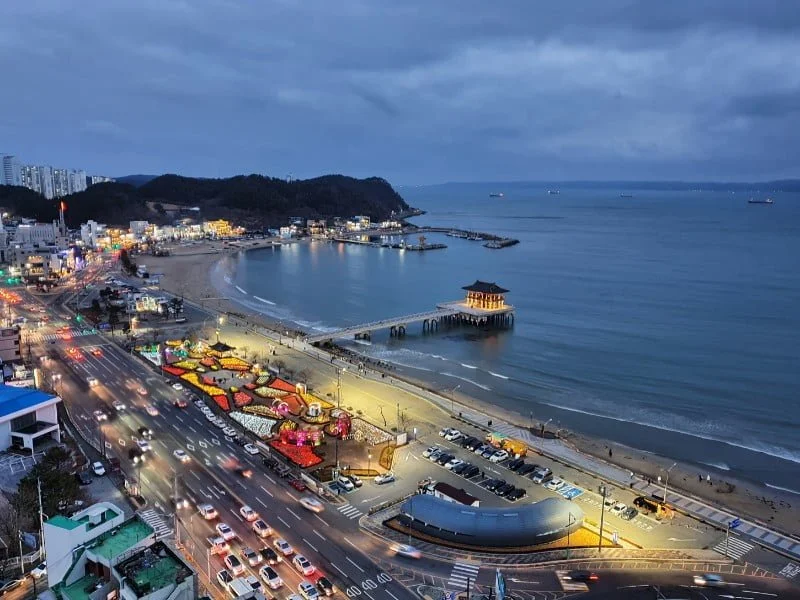
Pohang Travel Guide: Final Thoughts
From the warm sands of its beaches to the rich tapestry of its history and the vibrant pulse of its cultural life, Pohang is a city that deserves a spot on every traveler’s itinerary. Whether you came for a glimpse of giant steelworks or the serene sunrise at Homigot, Pohang leaves an indelible mark.
Beyond the Blast Furnaces
A City of Surprises: Pohang might be synonymous with steel, but its heart beats with natural beauty and historical depth. The contrasts here are striking—from the fiery furnaces of POSCO to the quiet, spiritual ambiance of Buddhist temples scattered around the city. It’s a place where every corner offers a new discovery, every experience enriches your journey.
A Cultural Melting Pot
Festivals and Feasts: If you time your visit right, Pohang’s cultural calendar is bustling with activity. The Pohang International Fireworks Festival lights up the summer sky, drawing visitors from across Korea and beyond. Meanwhile, the local cuisine, with its emphasis on fresh seafood, offers a taste of the coastal life that has shaped this community for generations.
Nature’s Haven
Serene Escapes: For those seeking tranquility, the beaches and hiking trails around Pohang provide a perfect retreat. The city serves as a gateway to natural wonders, where the stresses of urban life melt away against the backdrop of lapping waves and lush mountainsides. Whether it’s a quiet morning walk along Yeongildae Beach or a challenging hike in the nearby hills, nature’s restorative powers are always within reach.
Final Thoughts
Pohang is a city that thrives on contrasts and surprises. Its blend of industrial heritage and natural beauty, tradition and modernity, creates a unique cultural landscape that captivates and charms. Pack your bags, set your itinerary, and prepare to discover the many layers of Pohang—a city truly worth the visit.
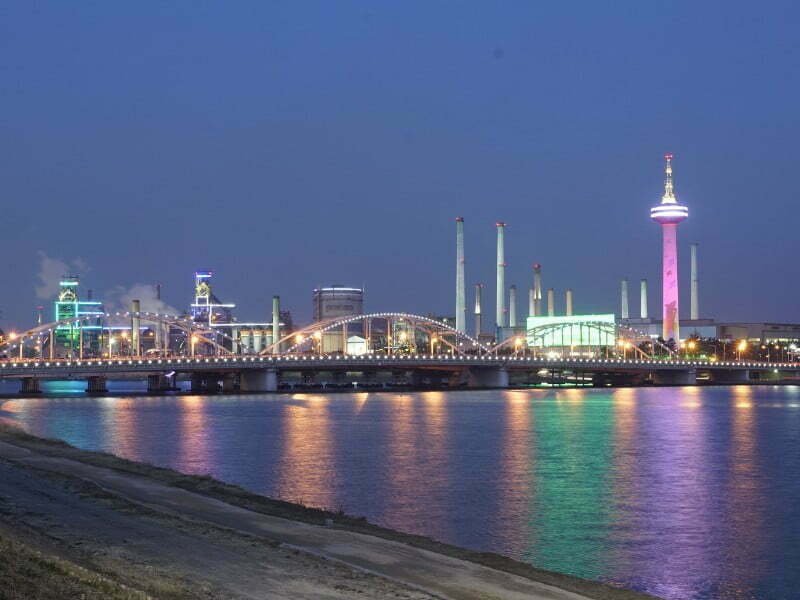
Ode To Pohang
The waves crash against the shore In Pohang, a city worth exploring more From the towering mountains to the sparkling sea There’s a world of wonder waiting for you and me
In this coastal city, there’s so much to see From ancient temples to modern technology The city’s history is rich and deep Its cultural heritage weaved into every street
The people here are kind and warm Welcoming visitors in every form With delicious food and stunning sights Pohang is a traveler’s delight
So come and explore this city by the sea Embrace its beauty and let your spirit free From the mountains to the shore Pohang is a place you’ll forever adore.
